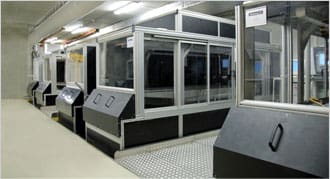TTAG reader Jeremy is not impressed with Cody Wilson’s 3D printable pistol. “The Liberator does suck,” Jeremy emails, “and people rag on it for good reason.” Yes but—“there is a company that will currently print your product from your drawing and they print in aluminum, stainless steel, titanium, bronze, brass, and plastics, etc. The defcad stuff renders in their system.” That would be i.materialise.com. “You can see for yourself that defcad’s drawings render perfectly in their system. Upload the attached AR-10 lower receiver file and it will appear in their 3D preview no problem.” Note: their machines are more than large enough to print an AR lower. Needless to say, the Belgian manufacturer is legally constrained from this sort of endeavor. However, the technology to print a robust firearm in a strong metal exists. And now that cat’s out of the bag, too.





I wonder why I didn’t have to take a background check to get into machining school? I could make guns that would make this plastic one-shooter look like a …plastic one-shooter.
Metal 3d printing has been around for a while.
http://exone.com/
The Liberator is a better concept and ideal than a firearm. It’s nowhere near perfect (or even practical), but it’s an eye opener, which is what I suspect is the intent of its design and release.
Best,
JBR
I’ve been thinking this for awhile. Also, I did some reading on MIM recently, and I wonder how long it will be before that technology is merged with 3D printing and made accessible to the masses. This type of technology will only decrease in price and increase in availability to the general population. The possibilities are endless.
I really dont see that as realistic, you still need a mill to create the mold. And if you have a mill, why do MIM unless youre mass producing something.
You just answered your own question.
There’s a reason why S&W uses MIM for lots of their small, fiddly little parts that used to be milled/shaped on fixtures, then hand-fitted. The consistency of part size, metallurgy and the lack of tooling cost for mass production are all very attractive features of MIM.
General Motors printed an 8-cylinder (I think) functioning engine within the last two years. It took 38 hours.
The technology will improve and spread. 3D Printing is the most disruptive thing in our near future. Remember the $14,000 32″ flat screen TV? Me neither.
But you get my point.
The first flat panel I remember was a 40″ Phillips for about $40,000.
I bought my 32″ with higher resolution, better quality picture, and more features for $540.
I can’t help but think of the Star Trek replicators.
I worked at GM monitoring manufactures who provided parts for us, as well as companies that wanted to provide us with parts. Laser cutting/engineering tech is not new. Not only has GM and many manufactures that make parts for GM “printed”, a more correct term would be “cut”, numerous parts already and have been for years, but the tech is the same as 3d printing. In reality is actually more advanced.
And no, GM did not print a working V8 engine. If they could it would probably take 2-3 months to complete at a cost of over 100k.
The only thing GM prints is prototype parts mostly body parts but they do spit out engines and transmissions and ect. at 1/3 scale, in plastic. They use SLS or selective laser sintering along with stereolithography. They have been using both for about a decade. None of these parts are used in final product, it just helps speed up designs therefore it speeds up production.
Lays down powdered metal and sinters it with a laser. About as strong as the “real” thing. Awesome.
I am more than sick and tired of people not realizing/acknowledging that 3D printing, regardless of the material, is just an additive manufacturing process. And that polymer/plastic/resin prints are simply inferior materials being used to rapidly proto-type mechanical parts…end of story. People keep behaving and reporting on this topic as if CAD was just invented yesterday.
The cat has never been in the damn bag!
This.
I think the interest is not about what CAD/3D printing can economically do now, but what it will enable everyone to do, soon.
I beg to differ…my cat LOVES bags, gets in ’em all the time!
“3D printing, regardless of the material, is just an additive manufacturing process”
Not according to these guys. It isn’t just various types of material powders held together with an additive (epoxy or melted plastic). With some of the metal ones, they’re actually using pure metal and using a laser to sinter (basically melt/weld) it together. The result it supposed to be just like it were the real-deal. From one part of the site: “Models made in titanium are printed in titanium powder that is sintered together by a laser to produce end-use metal parts that are as equally good as machined models.”
With some of the metal ones, they’re actually using pure metal and using a laser to sinter (basically melt/weld) it together.
It still makes it an additive manufacturing process, compared to a subtractive one like a mill or lathe.
It still makes it an additive manufacturing process, compared to a subtractive one like a mill or lathe.
Oh I get it. I thought he meant using an additive as a binder to the base material or something. Gotcha… building up rather than taking away. Okay. Cool. Is that supposed to be bad? I’d rather not pay for all of the scrap that gets cut out of a part ;-). If the end result is functionally the same, I don’t really give a crap how it’s actually made. Could be pooped out by a fairy for all I care haha
I’m not a machinist but from my understanding selective laser sintered parts are always weaker than something which has been machined from a solid block. And with subtractive processes, you can always sell the scrap bits which are left over.
To say sintered parts were of comparable quality to machined parts is kind of weaselly, because while it could be true (whether it’s machined or not says nothing about the quality of the starting stock) it generally isn’t.
Well said Billy.
Imagine if you could walk into a Kinkos or Staples and pay to ‘print’ a 3D item…
“That was easy”
Click. Print. Shoot.
Comments are closed.